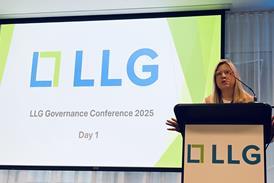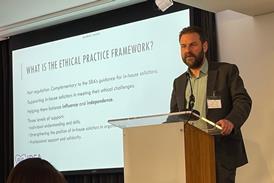Alleged copyright infringements in the training of AI models, compulsory mediation and the boundaries of Brexit are among the recent landmark developments exercising IP lawyers. Joanna Goodman reports
The low down
In the early weeks of 2025, IP lawyers have seen the first ruling in the UK to require compulsory mediation, and an important and high-profile decision in a lookalike products dispute. Landmark cases are also proliferating that will partially determine the scope and scale of the rollout of artificial intelligence, as copyright owners battle the allegedly illegal use of their content to train AI models. Thomson Reuters scored a ‘stunning’ win just last week on fair use of the legal information platform Westlaw, but is the judgment really as significant as it appears? Across the Atlantic, too, president Trump’s aversion to multilateralism has raised fears about the future of cross-border enforcement.
2025 is already a significant year for intellectual property law, due to the intensifying debate over the use of copyright material to train generative AI models and tensions between different IP regimes. Significant cases are bringing clarity to a confusing landscape. In the US, however, president Trump is less than keen on international organisations, including IP courts and institutions, whose rulings have extra-territorial effect.
A major concern for the creative industries is the extent to which copyright works can be used to train AI models. Governance and regulation means balancing the interests of AI developers and copyright owners. While prime minister Sir Keir Starmer plans to turbocharge the UK’s AI sector, the UK’s creative industries bring £126bn to the UK economy and employ 2.4 million people.
The government’s consultation on text and data mining (TDM), open until 25 February, asks for feedback on potential options. These include: leaving copyright laws unchanged; an opt-in model requiring licensing, which would strengthen copyright protection but conflict with the government’s AI plans; a broad TDM exception, which would provide no protection for the creative industries; and the government’s preferred option, an opt-out model. This would allow AI developers to train their models on copyrighted content, introduce transparency measures requiring developers to reveal what material their AI models have been trained on, and give copyright owners the opportunity to opt out. This last option would reflect the Digital Copyright Directive ((EU) 2019/790.
Pushback from the creative industries was echoed during the report stage of the Data (Use and Access) Bill. This received its second reading in the Commons last week, having been significantly amended in the Lords, where it originated. The amendments, introduced by film-maker Baroness Kidron, propose an alternative, enforceable copyright regime.
She explained: ‘Amendment 61 would ensure that all operators of web crawlers must comply with UK law if they are marketed in the UK. Amendments 62 and 63 would require operators to be transparent about their identity and purpose, and allow creatives to understand if their content had been stolen. Amendment 64 would give enforcement powers to the ICO (Information Commissioner’s Office) and allow for a private right of action by copyright holders. Amendment 44A would require the ICO to report on its enforcement record. Finally, Amendment 65 would require the secretary of state to review technical solutions that might support a strong copyright regime.’
She added: ‘My amendments mandate that companies have to account for where and when they take the material and make it transparent. It makes copyright law fit for the age of AI. It makes tech accountable.’
As Nina O’Sullivan, partner and head knowledge lawyer (contentious) at Mishcon de Reya, observes, this raises challenges for the government beyond territorial boundaries. ‘While the government has said that its preferred approach of an exception for text and data mining with rights-holder opt-out aligns with the approach already adopted the EU, there is one crucial difference. The EU regime purports to implement extra-territoriality – requiring those putting general purpose AI models on the market in the EU to comply with EU copyright law wherever the models were trained. The UK consultation merely says that the government wants to “encourage” AI developers operating in the UK to comply with UK law on AI model training, even where their models are trained in other countries, but with little information as to how this encouragement may bear fruit.
‘Interestingly, one of the proposed amendments to the Data (Use and Access) Bill requires model developers to comply with UK copyright law regardless of where the … pre-training, development and operation take place. Of course, it is likely that these amendments will not survive, but the government will need to face this issue head on when it responds to the consultation.’
Meanwhile, AI copyright infringement cases are increasing, mostly in the US, where there are currently 38 copyright lawsuits against AI companies, as well as in the UK, Germany, Canada, China and India. ‘The latest US claim was filed on 13 February in New York by a group of news publishing companies, including the Guardian, against Cohere’s Command models, and raises some interesting questions around RAG (retrieval augmented generation) techniques and hallucinations,’ says O’Sullivan.
The biggest UK AI copyright infringement case is Getty Images (US) Inc and Ors v Stability AI, in which Getty Images claims that 12 million images were scraped from its website, without consent, to train and develop Stable Diffusion, Stability AI’s text-to image GenAI model. The first trial to determine liability is listed to commence in June.
‘While the focus of the discussion on the Getty case to date has largely been on jurisdictional issues relating to the training of the Stability AI models, it will be interesting to see how the court deals with other important questions, particularly around allegedly infringing outputs and where liability for those might fall, as well as any potential defences that might arise,’ O’Sullivan observes.'
'We don’t yet have significant new laws that cover AI technology, so a lot of our work is looking at how AI use fits into existing legal frameworks'
Sam Goodman, Lee & Thompson
Michelmores IP partner Iain Connor explains that the case revolves around the underlying use of copyright protected materials, and whether the tool [Stable Diffusion] is an infringing article. ‘Because the act of copying took place outside the UK, the UK court cannot determine on that,’ he says. ‘But it will decide whether using a tool that has been illegally trained on copyright material can be lawfully used in the UK. This relates directly to the TDM exception that the Lords were discussing. At the moment, TDM is permitted in the UK for non-commercial purposes. For commercial purposes, [existing] copyright laws apply, which means that you need permission from the copyright owners to train your AI model. We will find out in the Getty Images case whether an AI model that was trained outside the jurisdiction can be used lawfully in the UK.’
Sam Goodman, commercial partner at Lee & Thompson, advises clients in the creative industries, many of whom use AI tools. ‘We don’t yet have significant new laws that cover AI technology, so a lot of our work is looking at how AI use fits into existing legal frameworks, for example in copyright infringement. In the Stability case, the evidentiary hurdle was easier to overcome, because the output included the Getty watermark, but if you’re a copyright holder, the biggest challenge is knowing how much of your work is being used, and how extensive that use is in order to build a claim in the first place.’
As often happens in AI and emerging tech, challenges produce opportunities. In a guest article in The Hollywood Reporter, Covington & Burling partners Adrian Perry and Robyn Polashuk describe a new market in licensed content for training AI, which gets around the inevitable lack of differentiation if GenAI models are trained on the same content. ‘AI developers are looking not only to mitigate risks during their training process but also to differentiate their AI models from peer technologies… At the same time, content creators and owners are seeking ways to monetise their content in the AI marketplace, and to limit the use of their intellectual property for the training of AI models without their express permission. Hence content creators are selling their unused video content to AI developers… This newly developing B-roll licensing market represents a unique common ground for AI developers and content owners to create a mutually advantageous relationship.’
Thomson Reuters wins landmark copyright case
In the US last week, Thomson Reuters won a precedent-setting AI copyright case, with a decision that training an AI model on copyrighted data does not constitute fair use. In a long-running dispute concerning legal information, Thomson Reuters v ROSS Intelligence, a legaltech start-up that developed an AI legal research tool, Circuit Court Judge Stephanos Bibas changed his 2023 ruling. He found that ROSS Intelligence could not rely on a fair use defence in relation to its use of Westlaw headnotes, which are created by Thomson Reuters editors, to train its Bulk Memos tool. Although Westlaw headnotes are created directly from public domain data, the court found that their selection from that data was directly replicated in the ROSS product. Furthermore, the output was being used commercially, in a competitor product. Nina O’Sullivan, partner and head knowledge lawyer (contentious) at Mishcon de Reya, explains that although ‘this decision has been described as “stunning” and is certainly significant – the case explicitly does not concern generative AI, and it may of course go on to appeal’. This is highly likely, given that on LinkedIn ROSS founder Andrew Arruda disputed the ruling, quoting Aaron Moss’s observation that ‘the output of ROSS’s Al tool – what Judge Bibas describes as “spitting back” to the user – is an unprotectable judicial opinion, not a Westlaw headnote’. As Kate Knibbs wrote in Wired, unlike ROSS Intelligence, which shut down in 2021 due to litigation costs (the lawsuit against it was originally filed in 2020), today’s GenAI companies, ‘like OpenAI and Google, are financially equipped to weather prolonged legal fights’.
2025 is already bringing new directions in IP disputes, notably the first case to require compulsory mediation and an important decision in a lookalike products dispute.
Courts were given the power to order parties to use alternative dispute resolution (ADR) in 2023, but DKH Retail Ltd and others v City Football Group Ltd [2024] was the first time it was applied. The claim arose from a dispute about the branding on the shirts of Manchester City players, which used the words ‘Super’ and ‘Dry’ to promote its sponsor, Asahi Super Dry 0.0% lager. The owners of Superdry clothing claimed that this could be associated with their brand.
As O’Sullivan explains, ‘the 2023 decision in Churchill v Merthyr Tydfil County Borough Council, that the court has the power to order unwilling parties to engage in ADR, has led to a radical rethinking of how all types of disputes should be conducted, including IP cases where historically there has been less of an emphasis on using ADR tools, due in large part to the nature of such disputes, and parties’ preferred outcomes. We’ve now had the first IP case, where the court has ordered the parties to mediate, despite Manchester City being reluctant to do so, and it appears that the mediation led to the parties resolving their dispute and the trial not going ahead.’
'Where there is a way through to a “win-win” outcome in an IP dispute … ADR is extremely attractive'
Nina O’Sullivan, Mishcon de Reya
‘It will be interesting to see if it is the first of many cases where parties are forced to mediate rather than litigate,’ observes Connor, adding: ‘While mediation is a good thing, as it allows parties to agree things the court cannot order, it is also confidential so we don’t know what the parties agreed, or why.’
ADR is not always the best route, however. ‘Where there is a way through to a “win-win” outcome in an IP dispute … ADR is extremely attractive,’ says O’Sullivan. ‘However, there will still be IP cases where that win-win may simply not be achievable, and one or other party will wish to proceed to court to determine important points of principle.’
Significant judgments are also helpful in respect of future (potential) disputes. ‘In January, the Court of Appeal delivered its judgment in Thatchers Cider Company Limited v Aldi Stores Limited [2025], upholding Thatchers’ appeal against a decision which had rejected its claim for trade mark infringement in relation to lookalike packaging for its cloudy lemon cider. Even though the marks were not confusingly similar, the court concluded that Aldi had taken unfair advantage of Thatchers’ trade mark for its packaging, underlining the value of securing registered protection,’ explains O’Sullivan.
‘It was clearly important to Thatchers to obtain a finding from the Court of Appeal on its arguments of unfair advantage, which it (and other brand owners) can now deploy going forward, including no doubt in any ADR discussions in future cases (subject of course to any appeal by Aldi to the Supreme Court).’
This is an influential judgment in two important respects, observes Connor. ‘First, it is likely to strengthen the position of established brands against supermarket own brands, and second, it is an example of EU law being followed in the absence of a clear alternative. Although the court was invited to depart from CJEU law, which is an option following Brexit, Lord Justice Arnold rejected this because he felt that it would create legal uncertainty.’

Social media is an important source of evidence in lookalike product disputes, adds Connor. ‘Reactions on social media are immediately relevant because they are spontaneous and prove that there is a link between the two products and the lookalike is damaging the sales of the original.’
He continues: ‘Decisions like this also show that the court is going to continue applying EU law in this area, and look closely at whether a supermarket intended to ride on the coat-tails of a big brand, and [supermarkets] are going to have to be super-careful because the court is likely to find [their own brands] unlawful.’
Another key point is that the big FMCG (fast-moving consumer goods) brands cannot bring this kind of case against supermarket own brands, because the supermarkets are their distribution channels, often for hundreds of products. They cannot risk that symbiotic relationship. But Thatchers, which only makes cider, was able to pursue Aldi, which does not stock its products, and create a precedent that will no doubt protect other brands.

Five years after Brexit, UK cases are still heavily influenced by its institutions, and not always because of legal uncertainty. The UK cannot join the Unified Patent Court (UPC) whose membership is only open to EU member states. But on 28 January, in Fujifilm Corporation v Kodak the Düsseldorf Local Division of the UPC ruled that if the defendant to a patent infringement action is domiciled in a contracting member state, the UPC can determine the infringement action in every country where those patents apply, even in countries which do not participate in the UPC system. This decision is the first UPC ruling on what is described as ‘long-arm jurisdiction’, i.e. extending its jurisdiction to hear the UK part of the claim.
As Connor explains, this is significant because ‘one of the reasons we didn’t join the UPC was political. We said that as an independent nation we would not be subject to the decisions of a court of another jurisdiction, and for members of the UPC the ultimate court is the CJEU. This case shows that in a particular set of circumstances, a UK patent could still be subject of the UPC.’
IP cases in the first quarter of 2025 show that while the UK is taking an independent line, IP disputes involving UK parties are still highly influenced by Europe. Increased mediation may muddy the waters.
Regarding AI and copyright, the UK is seeking to balance a regulatory stance which echoes the EU AI Act with a more liberal approach (closer to that of the US) that would boost the UK’s AI sector, for example by broadening the scientific use case in the Data (Use and Access) Bill to include commercial purposes. As Goodman at Lee & Thompson observes: ‘While this doesn’t give developers carte blanche, it might provide some cover to developers operating at the edge of what’s lawful/acceptable. It feels like there’s been a shift globally between regulators saying we need to ensure AI is used safely and responsibly to promoting innovation and worrying about being left behind.’
Another point of friction between regulation and innovation is that AI regulation is forward-looking, so it is important to ensure that any new legal requirements, for example around disclosing training data, do not deter new market entrants at the expense of established players, or drive away the best developers.
Although this feels that the UK regulations are biased towards AI developers rather than the owners of the content they need, the position is likely to be balanced by the outcome of multiple pending cases, and the new ways of monetising content. IP is definitely a practice area to watch.
































No comments yet